

| Peace Museums
Around the World |
A "peace museum" promotes "peace" as the "absense of war." Usually (but not always), the word "peace" (or "anti-war") is in the name of the musuem. A peace museum displays the horrors of war and the blessings of peace. Some peace museums do more.
This webpage shows 53 peace museums: 20 in Europe, 17 in Japan, 7 in the United States, and 9 in other countries. (A few of these no longer exist, and one or two have not yet opened.) Other lists of peace museums may be found on Wikipedia, the website of the International Network of Museums for Peace (INMP), and the website of the
Kyoto Museum for World Peace.
The term "museum for peace" (sometimes called a "peace-related museum" or "issue-based peace museum") includes peace museums but is more broadly defined. Often the word "peace" is not in the name of the museum. A museum for peace promotes any kind of peace or human rights. Typically, a museum for peace focuses on a particular "issue" or barrier to peace -- not only war but other forms of violence, crime, conflict, discrimintion, intolerance, poverty, segregation, ignorance, slavery, terrorism, environmental abuse, etc. -- and ways to overcome the barrier. Some museums for peace celebrate specific peace events or peacemakers, e.g. Mahatma Gandhi, Martin Luther King, Jr., or other Nobel Peace Prize laureates.
This webpage shows 36 selected museums for peace (in addition to 51 peace museums): 12 in Europe, 9 in Japan, 7 in the United States, and 8 in India. This is a small sample of many museums which could be called "museums for peace." Click here to see about 200 additional museums for peace (and centers for peace) in the United States and Canada.
Click here for a table comparing "peace museums" with "museums for peace" and giving many examples of each.
Click here for "The Making of a Peace Museum Tradition: Case-Studies from Japan and Cambodia" by Terence Duffy (2003).
Click here for an illustrated commentary on peace and war museums in Japan by Takashi Yoshida.
20 Peace Museums in Europe
Right click image to enlarge.



| 1902 - International Museum of War & Peace, Lucerne (Switzerland). Opened by Ivan Bloch, aka Jean de Bloch [1836-1902], a Polish-Russian entrepreneur and author of the 6-volume master work, La Guerre Future / Is War Now Impossible? (1898). Destroyed during World War I. See "The International Museum of War and Peace at Lucerne" by Peter van den Dungen, Schweizerische Zeitschrift fur Geschichte, vol, 31, pp, 185-202 (1981). Click here for "Preventing Catastrphe: The World's first peace museum" by Peter van den Dungen, Ritsumeikan Kokusai Kenkyu / The Ritsumeikan Journal of International Studies, vol. 18, no. 3, pp. 23-36 (March 2006). Site now occupied by Kultur- und Kongresszentrum Luzern (KKL) / Culture and Congress Centre in Lucerne designed by French architect Jean Nouvel.
|



| 1925 - Anti-Kriegs-Museum (AKM) / Anti-War
Museum, Brusseler Strasse 21, Berlin (Germany). Founded by anarchist and pacifist Ernest Friedrich [1894-1967], whose book "War against War!" (1924) is a shocking picture-book documenting the horrors of World War I. In March 1933, Nazi storm troopers (SA) destroyed the AKM. Friedrich was arrested, then emigrated to Belgium & France. AKM reopened in 1982, 15 years after the death of its founder.
|


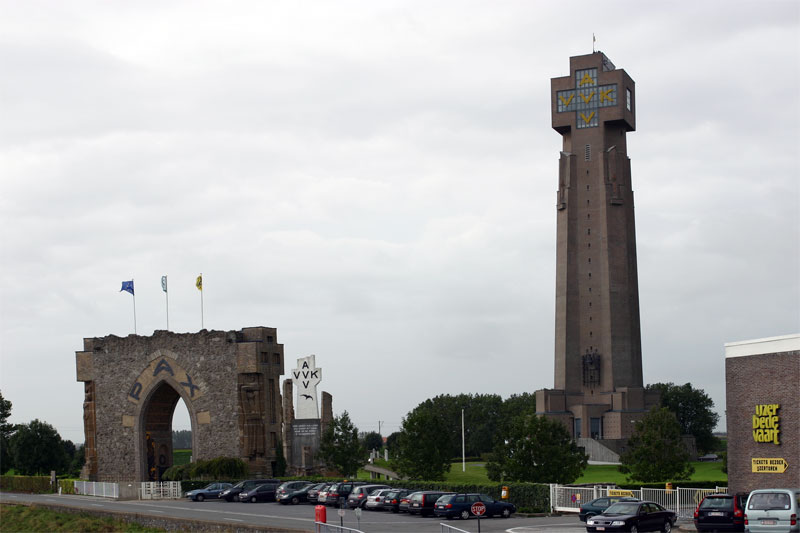


| 1930 - IJzertoren Museum of War, Peace & Flemish Emancipation, IJzerdijk 49, Diksmuide / Dixmude, Flanders (Belgium). IJzertoren / Yser Tower is is named after the Yser River which formed the frontline during most of World War I. The 84-meter tower was iIllegally demolished the night of March 15-16, 1946. The perpetrators were never caught but were thought to involve Belgian military and former resistance fighters in an atmosphere of post WW-II repression. Site of 4th International Conference of the International Network of Museums for Peace (INMP). Images show the rebuilt tower. Upper left image is 1929 poster. Upper right image is brochure for the 4th INMP conference in 2003.
|

| 1980 - Friedensmuseum Landau / Landau Peace Museum, Lindenhofwe 25, Lindau/Bodensee (Germany). Operated by Pax Christi, Diocese of Augsberg. On Lake Constance.
|

| 1981 - Antikriegshaus Sievershausen / Sievershausen Anti-War House & Peace Center, Kirchweg 4, Sievershausen (Germany).
|

| 1982 - Friedensmuseum der Kirchengemeinde / Peace Museum, Schulstrasse 2, Meeder (Germany). Operted by Lutheran Parish of Meeder, St. Laurentius. Promotes the peace tradition which emerged in this area in 1651 at the end of the Thirty Years War.
|

| May 31, 1984 - Friedensbibliothek und Antikriegsmuseum / Peace Library & Anti-War Musuem, Haus der Demokratie und Menschenrechte, Greifswalder Strase 4, Berlin (Germany). Operated by Evangelical Church of Berlin-Brandenburg.
|

| 1987 -
Vredescentrum van de Provincie en de Stad Antwerpen / Peace Centre of the Province & City of Antwerp, Unolaan 1, Deurne-Antwerpen (Belgium). Four permanent exhibitions: Middle Ages, World War I, inter-war period, and World War II.
|
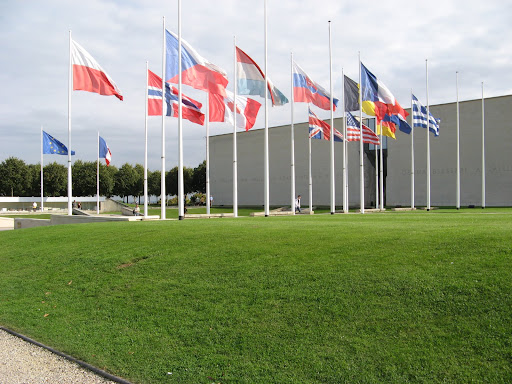

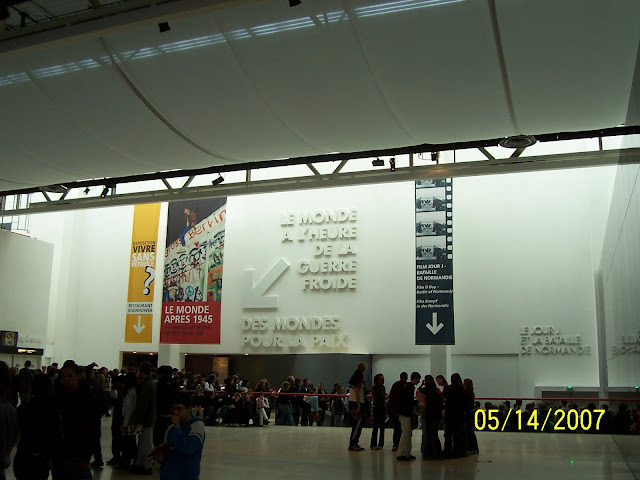

| 1988 - Memorial pour la Paix de Caen /
Caen Peace Museum, Esplanade General Eisenhower, Caen, Normandy (France). Principally about World War II but includes other themes, including a
gallery of Nobel Peace Prize laureates and an exhibit about conflict resolution in different cultures.
|

| 1993 - Erstes Osterreichisches Friedensmuseen / First Austrian Peace Museum, Heimatkreis Wolfsegg, Schulstrasse 18, Marktgemeinde Wolfsegg, Wolfsegg (Austria).
|

| August 5, 1995 - Yi Jun Peace Museum, The Hague (Netherlands). Established on 50th anniversary of Korean liberation from Japan and on 88th anniversary of death of Yi Jun [1859-1907] who died in this building after attempting to attend the Second Hague Peace Conference of 1907.
|

| April 7, 1998 - Museo de la Paz de Gernika / Gernika Peace Museum, Foru plaza,1. E 48300 Gernika-Lumo, Euskadi (Spain). Site of 5th International Conference of the International Network of Museums for Peace (INMP) in 2005. Image shows the museum's reproduction of Guernica, the famous 1937 painting by Pablo Picasso.
|

| 1998 - "In Flanders Fields" Museum, City of Ieper, Lakenhallen Grote Markt 34, Ieper / Ypres (Belgium). In historic Lakenhallen / Cloth Hall. Depicts World War I.
|

| 1998 - Friedensmuseum Nürnberg / Nürnberg Peace Museum, Kaulbachstrasse 2, Nürnberg (Germany). Documents the German peace movement.
|

| December 10, 2000 - Museo de la Paz en la Vall d'Uixó / Peace Museum in Vall d'Uixó,
Museu de la Pau, Centre Cultural Palau de Vivel, Vall d'Uixó, Castellón (Spain).
|

| 2001 - Europäische Museum für den Frieden / European Museum for Peace, Burg Schlaining, Rochusplatz 1, Stadtschlaining, Bergenland (Austria). "An offshoot of the Provincial Exhibition on 'War or Peace.'" Associated with the Österreichische Studienzentrum für Frieden und Konfliktlösung (ÖSFK) / Austrian Study Center for Peace & Conflict Resolution (ASPR).
|

| June 2005 - Nobels Fredssenter / Nobel Peace Center, in old west-bound railway station, Oslo (Norway).
Presents all Nobel Peace Prize laureates, arranges exhibitions, and tells the story of Alfred Nobel [1833-1896] and all the other Nobel prizes. Click here
for Wikipedia article. Operated by Nobel Foundation (Stockholm) & Norwegian Nobel Institute (Oslo).
|
 | Future - Peace Museum, Leeds Metropolitan University (LMU), Leeds (England). In partnership with The Peace Museum of Bradford (England). Will be associated with the new Senator George Mitchell Centre for Peace and Conflict Resolution.
|
17 Peace Museums in Japan
Right click image to enlarge.



| August 24, 1955 - Hiroshima Peace Memorial Museum, 1-2 Nakajima-cho, Naka-ku, Hiroshima (Japan). At site of the atomic bomb on August 6, 1945. New museum building (left) + original building (center) + conference center (right). One of 3 institutions hosting 6th International Conference of the International Network of Museums for Peace (INMP) in October 2008. One of 9 Japanese institutions described in brochure for 6th International Conference of the INMP in 2008. #27 of 56 "cenotaphs & monuments" on the Virtual E-Tour. Click here for Wikipedia article. Click here for other peace monuments in Hiroshma.
|
 | August 9, 1955 -
Atomic Bomb Museum, 7-8 Hirano-machi, Nagasaki (Japan). At site of the atomic bomb on August 9, 1945. Originally named Nagasaki International Cultural Hall. New building constructed in 1996. One of 9 Japanese institutions described in brochure for 6th International Conference of the INMP in 2008. Click here for Wikipedia article. Click here for peace monuments in Nagasaki.
|

| 1975 - Okinawa Prefectural Peace Memorial Museum, Peace Memorial Park, 614-Imabuni, Itoman, Okinawa (Japan). Relocated to new building in 2000. (Image shows the new building.) One of 9 Japanese institutions described in brochure for 6th International Conference of the INMP in 2008. Near the Cornerstone of Peace & other peace monuments. Click here for peace monuments in Okinawa.
|
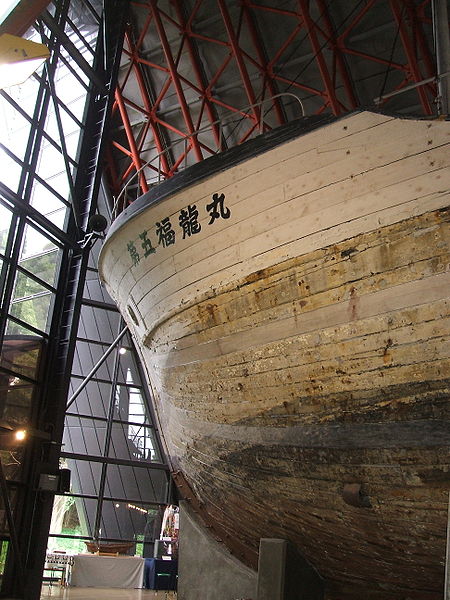
| 1976 - Display House of the Daigo Fukuryu-Maru / Fifth Lucky Dragon, 3-2 Yumenoshima, Koto-ku, Tokyo (Japan). Displays the tuna fishing boat contaminated by the US hydrogen bomb test at Bikini Atoll on March 1, 1954.
|

| 1977 - Japan Peace Museum, Shiba 1-4-9, Minato-ku, Tokyo (Japan). On-line museum (no physical displays). Operted by the independent "Citizens' Campaign to Establish Peace Museums, Peace Rooms & Corners in Japan."
|
 | April 1988 - Honkawa Elementary School Peace Museum, on right bank of Honkawa River, Hiroshima (Japan). Occupies portion of school building damaged by the A-bomb on August 6, 1945. #01 of 56 "cenotaphs & monuments" on the Virtual E-Tour. Click here for Wikipedia article.
|



| November 6, 1989 - Grass Roots House Peace Museum, 9-11 Masugata, Kochi City, Kochi Prefecture (Japan). "A grass roots approach to peace education and environmental issues." Privately owned by an association of 600 members. Annual exhibiltions on the Kochi air raids.
|

![]()


| 1991 - Osaka International Peace Center (Peace Osaka), 2-1 Osaka-jo, Chuou-ku, Osaka (Japan). Three primary themes: The Osaka air raid, the 15-Year War & Aspiration for Peace. One of 9 Japanese institutions described in brochure for 6th International Conference of the INMP in 2008.
|



| May 1992 - Kyoto Museum for World Peace (Daigaku Kokusai Heiwa Myujiamu), Ritsumeikan University, 56-1 Kita-machi, Toujiin, Kita-ku, Kyoto (Japan). "World's first peace museum established in a university." Director was Professor Ikuro Anzai. One of 3 institutions hosting 6th International Conference of the International Network of Museums for Peace (INMP) in October 2008. One of 9 Japanese institutions described in brochure for 6th International Conference of the INMP in 2008.
|



| 1992 - Kawasaki Peace Museum, Nakahara Peace Park (qv), Kizukisumiyoshi-cho, Nakahara-ku, Kawasaki, Kanagawa Prefecture (Japan). Site of base given up by U.S. Army in 1975. One of 9 Japanese institutions described in brochure for 6th International Conference of the INMP in 2008. Kawasaki is adjacent to Tokyo. Right photo by EWL.
|
1.JPG)
| 1993 - Peace Museum of Saitama, 241-113 Iwadono,
Higashi Matsuyama, Saitama Prefecture (Japan). One of 9 Japanese institutions described in brochure for 6th International Conference of the INMP in 2008.
|

| 1994 - Sakai City Peace & Human Rights Museum (Phoenix Museum), Sakai City Education & Cultural Centre (Sophia Sakai Planatarium), 1426 Shimizucho, Fukaishimizu-cho, Naka-ku, Sakai City, Osaka Prefecture (Japan). Celebrates Sakai City's Declaration for Protecting Human Rights (1980) & Non-Nuclear Peace Declaration (1983).
|

| 1995 - Oka Masaharu Memorial Peace Museum, 9-4 Nishizakacho, Nagasaki (Japan). Founded by private citizens to bring Japanese aggression to light.
|



| March 9, 2002 - Centre of the Tokyo Raid & War Damage, Kitasuna 1-5-4, Koto-ku, Tokyo (Japan). Documents the fire bombing of downtown Tokyo (Shitamachi) by some 300 American bombers on March 10, 1945. Director is Katsumoto Saotome. Right image shows "Children's World Peace" statue.
|
 | April 2002 - Fukuro-machi Elementary School Peace Museum, 6-36, Fukuromachi, Naka-ku, Hiroshima (Japan). Occupies portion of school building damaged by the A-bomb on August 6, 1945. Click here for Wikipedia article.
|

| Summer 2005 - Women's Active Museum of War and Peace (WAM), 2-3-18 Nishiwaseda, Shinjuku-ku, Tokyo (Japan). "A place where the reality of war crimes is recorded and kept for posterity. We come here to remember historical facts about 'comfort women,' and to listen to their stories. And we raise our voices and say, 'Never Again, anywhere in the world.'"
|
 | November 3, 2006 - Chukiren Heiwakinenkan / Chukiren Peace Memorial Museum, 1947-25 Kasahata, Kawagoe, Saitama Prefecture (Japan). Chukren = Chuhgoku Kikansha Renraka / Association of Returned Solidiers from China. "The core of the museum’s collection, housed in a 180-sq meter warehouse, is the testimony of 300 Japanese veterans who confessed while in custody in China to committing atrocities there, including rape, torture and infanticide. Graphic video and photographic evidence showing some of the most brutal crimes of the Imperial Japanese Army is held in the archives as a resource for scholars."
|
7 Peace Museums in the United States
Right click image to enlarge.

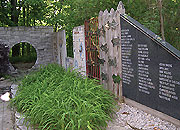

| 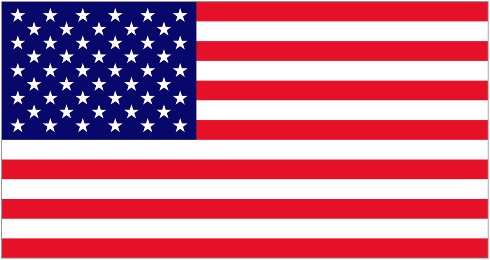  1987 -
Lion & Lamb Peace Arts Center, Bluffton University, Riley Court (Lower Level), Spring Street, Bluffton, Ohio (USA). Several other peace monuments are on the grounds of the center. Right image shows Moon Gate and Peace Wall. Entry #790 in the "Peace Movement Directory" by James Richard Bennett (2001). 1987 -
Lion & Lamb Peace Arts Center, Bluffton University, Riley Court (Lower Level), Spring Street, Bluffton, Ohio (USA). Several other peace monuments are on the grounds of the center. Right image shows Moon Gate and Peace Wall. Entry #790 in the "Peace Movement Directory" by James Richard Bennett (2001).
|

|   1981 - The Peace Museum, Chicago, Illinois (USA). Founded by Mark Rogovin & Marjorie Craig Benton. "First & only of its kind in the US, exploring the impact of war & peace through the arts." "Will be sharing space with other cultural organizations in the future. Our first exhibition in shared space opens November 8, 2008, at the Chicago Public Library..." Lost its original space?
Entry #276 in the "Peace Movement Directory" by James Richard Bennett (2001). 1981 - The Peace Museum, Chicago, Illinois (USA). Founded by Mark Rogovin & Marjorie Craig Benton. "First & only of its kind in the US, exploring the impact of war & peace through the arts." "Will be sharing space with other cultural organizations in the future. Our first exhibition in shared space opens November 8, 2008, at the Chicago Public Library..." Lost its original space?
Entry #276 in the "Peace Movement Directory" by James Richard Bennett (2001).
|



|   1994 - Prairie Peace Park, Seward, Nebraska (USA) -- 7 miles west of Lincoln on Interstate Highway 80 (exit 388). Peace museum primarily for children, created and owned by Don Tilley. Closed in 2005, but some of its outdoor displays remain. Included 16 sculptures of Sadako Sasaki. Entry #582 in the "Peace Movement Directory" by James Richard Bennett (2001). 1994 - Prairie Peace Park, Seward, Nebraska (USA) -- 7 miles west of Lincoln on Interstate Highway 80 (exit 388). Peace museum primarily for children, created and owned by Don Tilley. Closed in 2005, but some of its outdoor displays remain. Included 16 sculptures of Sadako Sasaki. Entry #582 in the "Peace Movement Directory" by James Richard Bennett (2001).
|
9 Peace Museums in Other Countries
Right click image to enlarge.
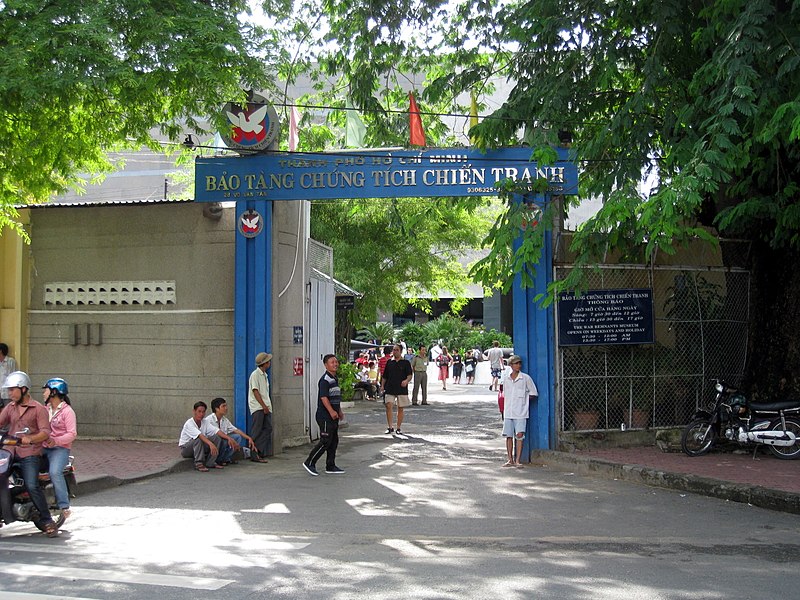
| 1975 - Bao tang chung tích chien tranh / War Remnants Museum, 28 Vo Van Tan, District 3, Ho Chi Minh City/Saigon (Vietnam). Former premises of the US Information Service (USIS). Formerly called the Museum of American War Crimes. Primarily contains exhibits relating to the American phase of the Vietnam War. A major tourist attraction.
|

| 1985 - Memorial Hall of the Victims in Nanjing Massacre by
Japanese Invaders, 418 Shuiximen Street, Jiangdongmen, Nanjing (China). Expanded in 1995 and 2005-2007. Now 25,000 square meters.
Click here for Wikipedia article. Has "academic cooperation agreement" with Kyoto Museum for World Peace. Whole building resembles a broken sword when seen from the side and a plow when seen from above.
|

| 1986 - Istoriceskij Muzej Samarkanda /
International Museum of Peace & Solidarity, Samarkand (Uzbekistan). "Museum runs a wide range of educational activities and international projects,
as well as housing about 20,00 exhibit pieces from over 100 countries. It's probably the only place in the world where visitors can see a piece of the Berlin Wall,
fragments of Soviet and US nuclear missiles, a part of an A-bombed roof tile from Nagasaki, soil from Auschwitz, in one place."
|

| July 6, 1987 - Museum of the Chinese People's War of Resistance Against Japanese Aggression, Bejing (China).
On the site where the Marco Polo Bridge Incident took place July 7-9, 1937.
|

| August 6, 1999 - No More Hiroshima : No More Nagasaki : Peace Museum, Indian Institute for Peace, Disarmament & Enironmental Protection (IIPDEP), 537 Sakkardara Road, Nagpur, Maharashtra (India). Museum & institute director, Dr. Balkrishna Kurvey, made presentation at 7th International Conference of Mueums for Peace, Kyoto (Japan), October 8, 2008.
|

| 2001 - Children's Museum for Peace & Human Rights (CMPHR), 9-C/1, 8th East Street, Phase 1, D.H.A, Karachi (Pakistan). "A logical extension of, and in partnership with, the Human Rights Education Programme (HREP) which had been working in Pakistan since 1995... The CMPHR hopes to move into its custom-built premises in 2010."
|

| 2003 - Museo para la Paz / Museum for Peace, La Fundación Arias para la Paz y el Progreso Humano,
Avenida Segunda, costado oeste Plaza de la Democracia, San José (Costa Rica).
|



| April 2004 - Kigali Memorial Centre, Kigali (Rwanda). "A reminder of the horrors of genocide in an attempt to stop history from repeating itself. The first floor retraces the events leading up to the 1994 genocide and details the heinous event itself. On the second floor is an area devoted to children who were killed in the genocide. Outside are the graves of over 250,000 people, and more are still being created as remains continue to be found."
|
12 Selected Other Museums for Peace in Europe
Right click image to enlarge.



| 1912 - Pamatnik Mohyla Míru / Cairn of Peace & Muzeum Brnenska / Brno Regional Museum, Prace, Moravia (Czech Republic). "85-foot monument commemorates Battle of Austerlitz (aka Battle of the Three Emperors), December 2, 1805, when Napoleon defeated the Austrian & Russian coalition, leading to the Peace of Pressburg (Bratislava). Within the memorial there is a chapel and small museum (moderized in 2005), while on the outside, four female statues symbolize France, Austria, Russia and Moravia."
|
 | August 28, 1913 - Vredespaleis / Peace Palace, The Hague (Netherlands). Constructed and still owned by the Carnegie Foundation. Now home of the International Court of Justice (ICJ) or World Court, the Permanent Court of Arbitration (PCA), the Peace Palace Library, and the Hague Academy of International Law.
|

| 1946 - League of Nations Museum, Palais des Nations, B.328, Geneva (Switerland). Operated by the Library of the UN Office at Geneva (UNOG), the League of Nations Archives (LON) & Historical Collections Unit. Illustrates the history & work of the League of Nations [1919-1946].
|

| 1959 - Museo Internazionale Della Croce Rossa / International Museum of the Red Cross, Via Garibaldi n.50, Castiglione delle Stiviere (Italy). Operated by the Italian Red Cross.
|

| October 19, 1962 - Museum Haus am Checkpoint Charlie (Mauermuseum), Friedrichsstrasse 43-44, Berlin (Germany). "First museum of international nonviolent protest." Operated by Arbeitsgemeinschaft 13 August e.V / 13th August Study Group. Four permanent exhibitions: "The Wall," paintings of "The Wall," Berlin, and "From Gandhi to Walesa." At present location since June 1963. Click here for Wikipedia article.
|

| 1967 - Musée Albert Schwietzer / Albert Schwietzer Museum, Gunsbach, Département de Haut-Rhin (France). Albert Schweitzer [1875-1965] fit construire cette maison en 1928 avec l'argent du Prix Goethe de la ville de Francfort.
|
  
 | 1969 - Henri Dunant Museum, Asylstrasse 2, Heiden (Switzerland). In the nursing home where he lived from 1892 until his death in 1910. "A special room is devoted to his vision of a world without war and social need."
|

| 1981 - Musée Albert Schweitzer / Albert Schweitzer Museum, 126, rue du Général de Gaulle, Kaysersberg, Alsace (France). "Ce lieu présente l'œuvre hospitalière du docteur à Lambaréné (Gabon) de 1913 à nos jours. " Next door to Schweitzer's birthplace (also shown in image).
|

| December 9, 1987 - Florence Nightengale Museum, Florence Nightingale Museum Trust,
Gassiot House, 2 Lambeth Palace Road, London, England (UK).
|
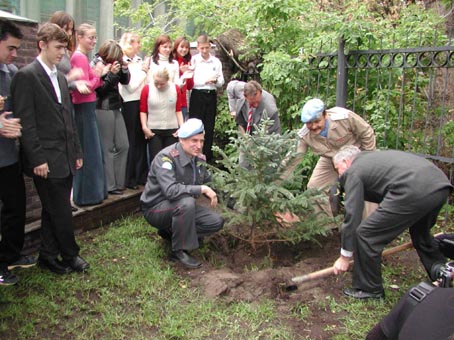
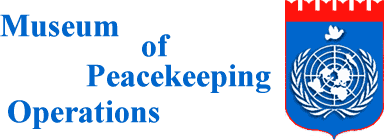

| 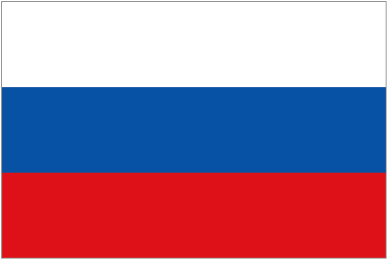 May 18, 1995 - Museum of Peacekeeping Operations, Dzerzinsky Street 20–57, Solnechnogorsk (Russia). Image shows planting of a Peace Tree at the museum. May 18, 1995 - Museum of Peacekeeping Operations, Dzerzinsky Street 20–57, Solnechnogorsk (Russia). Image shows planting of a Peace Tree at the museum. 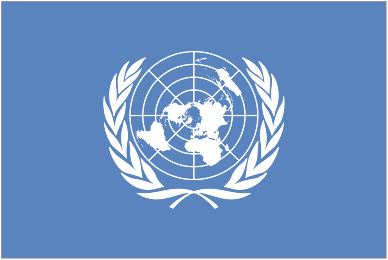
|

| December 1999? - Sugihara House-Museum, 30 Vaizganto Street, Kaunas/Kovnos (Lithuania). Two-story residence at which Jewish refugees once lined up in their hundreds to receive visas form Shiune Sugihara [1900-1986], consul of the Empire of Japan in Lithuania. Kaunas is Lithuania's second largest city.
|

| Date? - "Banquet de l’Humanité," Agropolis-Museum, 951 avenue Agropolis, Montpelier (France). Displays how each one eats according to one’s income, food resources and cultural background.
|
9 Selected Other Museums for Peace in Japan
Right click image to enlarge.
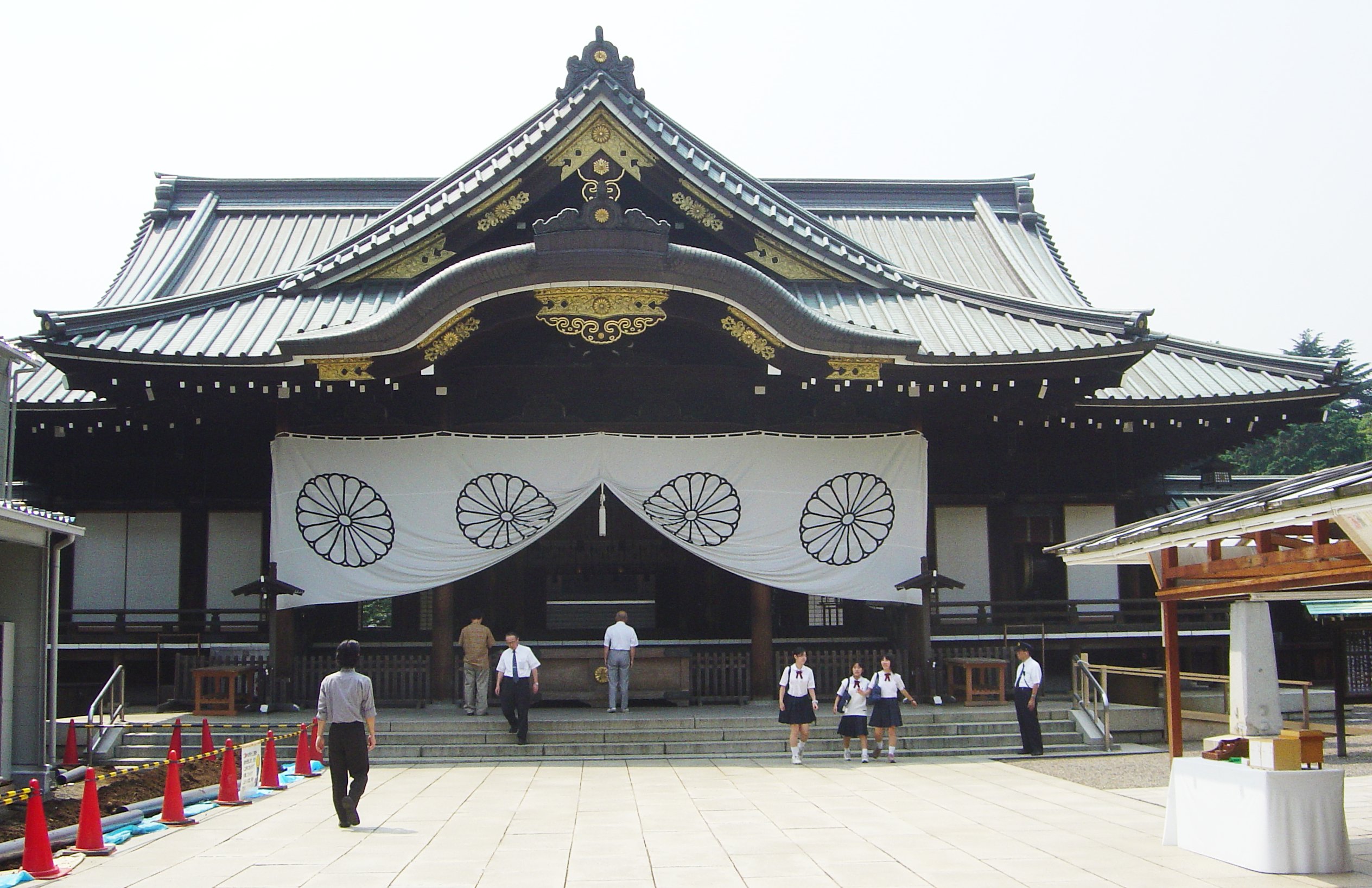

| June 1869 - Yasukuni Jinga / Yasukuni Shrine and Yushukan Museum, Chiyoda-ku, Tokyo (Japan). Shinto shrine for "divinities" who died fightng on behalf of the Emperor of Japan and adjacent museum which critics believe glorifies Japan's aggressive militaristic past. Official brochure says Yasukuni means "preserving peace for the nation," and Yushukan "is filled with...the sincerity of enshrined divinities who devoted themselves to build 'a peaceful nation.'" For Wikipedia articles, Click here for Yasukuni, and click here for Yushukan.
|


| 1967 - Maruki Gallery for the Hiroshima Panels, 1401 Shimoarako, Higashi Matuyama, Saitama Prefecture (Japan). Preserves 14 of the 15 panels painted by Iri & Toshi Maruki between 1950 & 1982 to show the atomic boming of Hiroshima & Nagasaki. Museum includes paintings of Auschwitz, Minamata & Nanking. Click here for Wikipedia article.
|
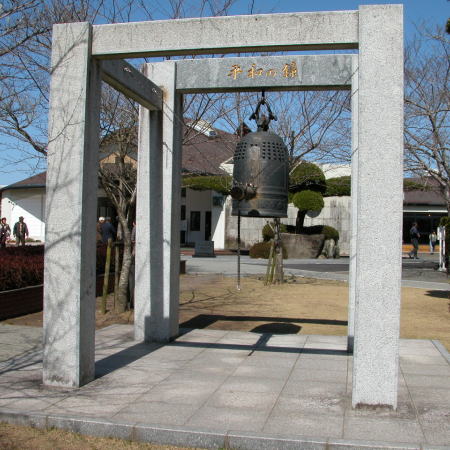


| 1975 -
Chiran Tokko Heiwa Kaikan /
Chiran Peace Museum for Kamikaze Pilots, Chiran, Kagoshima Prefecture, Kyushu Island (Japan). On site of the former Chiran Air Base. Tokko = tokubetsu kogeki / special attack (which was the Japanese euphemism for kamikaze).
|

| 1977 - Kyoto University of Art & Design, 2-116 Uryuzan, Kitashirakawa, Sakyo-ku, Kyoto (Japan). "One of the largest art universities in Japan with 10,000 students enrolled... Has 'Peace Building by Art' as the academic philosophy." One of 3 institutions hosting 6th International Conference of the International Network of Museums for Peace (INMP) in October 2008. One of 9 Japanese institutions described in brochure for 6th International Conference of the INMP in 2008.
|

| Date? - National Showa Memorial Museum (Showakan / Showa Hall), 1-6-1 Kudan-minami, Kudanshita, Chiyoda-ku, Tokyo (Japan). Originally named National Peace Memorial. From paper by Takashi Yoshida: "The Ministry of Health and Welfare initially intended the memorial to commemorate only the 3.5 million Japanese war dead. However, the Communist and the Socialist parties urged that the memorial should acknowledge the devastations and destructions inflicted on other Asian countries by the Japanese empire. The resulting compromise is a facility that commemorates the suffering of all Japanese both during and immediately after the war and exhibits artifacts with as few explanations as possible to avoid any controversy." Click here for official website in Japanese.
|

| 1996 - Himeji Historical Peace Centre, 475 Nishi-nobusue, Himeji, Nyogo Prefecture (Japan). Depicts World War II desruction and subsequent restoration of Himeji Castle (1580).
|

| 1998 - Kanagawa Plaza for Global Citizenship (KPGC) - Earth Plaza, 1-2-1 Kosugaya, Sakae-ku, Yokohama, Kanagawa Prefecture (Japan). Exhibits particularly oriented to children. One of 9 Japanese institutions described in brochure for 6th International Conference of the INMP in 2008.
|

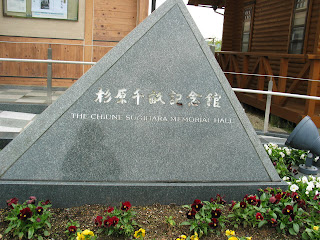

| July 2000 - Chiune Sugihara Memorial Hall & Museum, 1071 Yaozu, Yaotsu-cho, Kamo-gun, Gifu Prefecture (Japan). Shiune Sugihara [1900-1986] was a Japanese diplomat who helped thousands of Jews leave the Soviet Union while serving as consul of the Empire of Japan in Lithuania. The musuem is his birthplace.
|
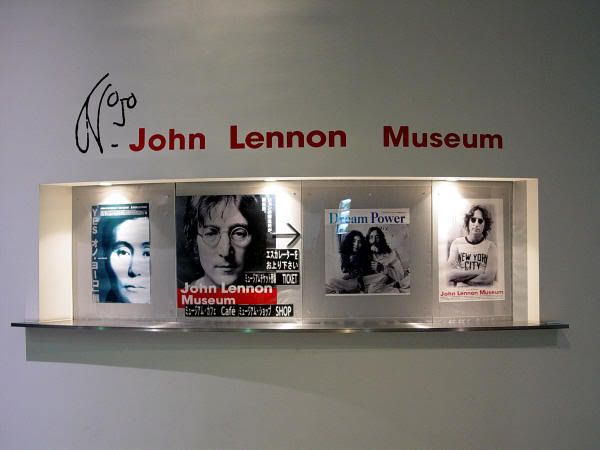

| October 9, 2000 - John Lennon Museum, Saitama Super Arena, 8 Shintoshin, Chuo-ku, Saitama City, Saitama Prefecture (Japan). "The first museum of its kind anywhere in the world." Supported by Yoko Ono.
|
7 Selected Other Museums for Peace in the United States
Click here for a much longer list of musuems for peace in the US & Canada.
Right click image to enlarge.

|   1963 - Woodrow Wilson House, National Trust for Historic Preservation, 2340 S Street, NW, Washington, DC (USA). Inset shows the house on Armistice Day, November 11, 1918. 1963 - Woodrow Wilson House, National Trust for Historic Preservation, 2340 S Street, NW, Washington, DC (USA). Inset shows the house on Armistice Day, November 11, 1918.
|

|   1986 - Swords Into Plowshares Peace Center & Gallery, Central United Methodist Church, 33 East Adams Avenue (corner of Woodward Avenue), Detroit, Michigan (USA). "5,000 sq. ft. art gallery, gift shop, children's corner & reference library." Still in operation? Image shows part an exhibition at the center about Paul Robeson. 1986 - Swords Into Plowshares Peace Center & Gallery, Central United Methodist Church, 33 East Adams Avenue (corner of Woodward Avenue), Detroit, Michigan (USA). "5,000 sq. ft. art gallery, gift shop, children's corner & reference library." Still in operation? Image shows part an exhibition at the center about Paul Robeson.
|

|   1986 - Peace Farm, Amarillo, Texas (USA). Twenty acres of land on the southern boundary of the Pantex Plant. "Established as an information source about the Pantex Plant and to stand as a visible witness against the weapons of mass destruction being assembled there." Includes the Madre Sculpture (as shown by the image) . 1986 - Peace Farm, Amarillo, Texas (USA). Twenty acres of land on the southern boundary of the Pantex Plant. "Established as an information source about the Pantex Plant and to stand as a visible witness against the weapons of mass destruction being assembled there." Includes the Madre Sculpture (as shown by the image) .
|



|   1993 - Museum of Tolerence, Simon Wiesenthal Center, 9786 West Pico Boulevard, Los Angeles, California (USA). Entry #87 in the "Peace Movement Directory" by James
Richard Bennett (2001). 1993 - Museum of Tolerence, Simon Wiesenthal Center, 9786 West Pico Boulevard, Los Angeles, California (USA). Entry #87 in the "Peace Movement Directory" by James
Richard Bennett (2001).
|
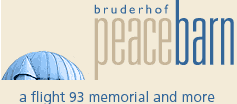
|   2001 - Bruderhof Peace Barn, Spring Valley Bruderhof, Farmington, Pennsylvania (USA). "Two days after 9/11/2001, the 5th through 8th grade students of the Spring Valley Bruderhof School wanted to do something for peace. They decided to convert an old barn into a museum for peace and a memorial for the victims of terrorism and war. In addition they have handcrafted memorial benches for each passenger and crew member of Flight 93, which are at the crash site in Shanksville, Pennsylvania." 2001 - Bruderhof Peace Barn, Spring Valley Bruderhof, Farmington, Pennsylvania (USA). "Two days after 9/11/2001, the 5th through 8th grade students of the Spring Valley Bruderhof School wanted to do something for peace. They decided to convert an old barn into a museum for peace and a memorial for the victims of terrorism and war. In addition they have handcrafted memorial benches for each passenger and crew member of Flight 93, which are at the crash site in Shanksville, Pennsylvania."
|



|   Fall 2010? - Headquarters and Public Education Center (PEC), US Institute of Peace (USIP), 23rd Street & Constitution Avenue, NW, Washington, DC (USA). Official ground breaking took place June 5, 2008, twenty-four years after the creation of USIP. The facility will consist of a training center for professional conflict managers, conference space for public and private meetings, office space for USIP staff, and a 20,000 square foot PEC. Entry #1169 in the "Peace Movement Directory" by James Richard Bennett (2001). Click here for the Wikipedia article. Fall 2010? - Headquarters and Public Education Center (PEC), US Institute of Peace (USIP), 23rd Street & Constitution Avenue, NW, Washington, DC (USA). Official ground breaking took place June 5, 2008, twenty-four years after the creation of USIP. The facility will consist of a training center for professional conflict managers, conference space for public and private meetings, office space for USIP staff, and a 20,000 square foot PEC. Entry #1169 in the "Peace Movement Directory" by James Richard Bennett (2001). Click here for the Wikipedia article.
|
8 Selected Other Museums for Peace in India
Right click image to enlarge.

| May 27, 1950 - Kirti Mandir / Gandhi Birthplace, Porbandar, Gugarat (India). House where Gandhi was born on October 2, 1869. Click here for a critique.
|
 | 1955 - Gandhi Memorial Museum, Gandhi Smarak Nidhi, Mahatma Gandhi Road, Tammukkam, Madurai (India). Housed in the historic Tamukkam Palace of Rani Mangammal of Nayak dynasty built about 1670 AD. Listed in UN directory "Peace Museums Worldwide" (1998).
|
 | January 30, 1961 - National Gandhi Museum & Library, Rajghat, New Delhi, (India). Occupied present location in 1961, but origins of the museum go back to 1951. Operated by Gandhi Smarak Sangrahalaya Samiti. Listed in UN directory "Peace Museums Worldwide" (1998).
|
 | Date? - Gandhi Mandapam / Gandhi Memorial, Kanniyakumari, Tamil Nadu (India). "Constructed at the spot where the urn containing the ashes of Mahatma Gandhi was kept for public view before a portion of its contents was immersed in the three seas. It resembles an Oriyan temple and was designed so that on Gandhiji's birthday (2nd October), the sun's rays fall on the place where his ashes were kept."
|
 | 1963 -
Gandhi Smarak Sangrahalaya / Gandhi Memorial Institution, Harijan Asram, Ahmedabad, Gugarat (India). On bank of Sabarmati River.
Click here for the Wikipedia article.
"Houses personal memorabilia of Mahatma Gandhi. Consequently the exhibits on view depict the vivid and historic events of Gandhiji's life.
There are books, manuscripts and photostat copies of his correspondence, photographs of Gandhiji with his wife Kasturba and other ashram
associates, life size oil paintings and actual relics like his writing desk and spinning wheel." Operated by Sabarmati Ashar Preservation & Memorial Trust. Listed in UN directory "Peace Museums Worldwide" (1998).
|
 | 1969 - Aga Kahn Palace, Pune, Maharashtra (India). Where Gandhi, his wife Kasturba & his secretary Mahadevbhai Desai were interned by the British from August 9, 1942 to May 6, 1944 (& where the latter two died). Palace of the Aga Khan constructed in 1892. Museum management transferred to the Gandhi Memorial Society in 1980.
|
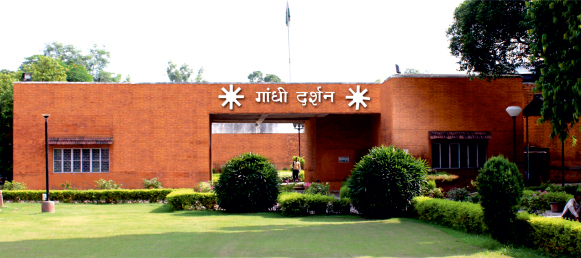 | 1969? -
Gandhi Darshan or Gandhi Samadhi, Rajghat, New Delhi (India). Merged in September 1984 with Gandhi Smriti (qv) to form "Gandhi Smriti and Darshan Samiti" (GSDS).
|

| August 15, 1973 - Gandhi Smriti, Birla Bhavan / Birla House, 5 Tees January Marg, New Delhi (India). Home of industrialist Ghanshyam Das Birla [1894-1983]. Now includes Gandhi museum, bookshop, room in which Gandhi lodged for 144 days after September 9, 1947, his last footsteps on January 30, 1948, and the garden in which he was assassinated. Merged in September 1984 with Gandhi Darshan (qv) to form "Gandhi Smriti and Darshan Samiti (GSDS).
|
 | 1993 - Robben Island Museum, Robben Island (South Africa). "The notorious prison on the Island was also used to exile political prisoners of the apartheid era between the 1960s and 1991. Today it is a World Heritage Site and museum, a poignant reminder to the newly democratic South Africa of the price some paid for freedom."
|













































![]()







1.JPG)








1798 - Peace-Office for the United States proposed by Dr. Benjamin Rush, Philadelphia, Pennsylania (USA). Benjamin Rush [1745-1813] was a Philadelphia phsysician and signer of the Declaration of Independence.




1987 - Lion & Lamb Peace Arts Center, Bluffton University, Riley Court (Lower Level), Spring Street, Bluffton, Ohio (USA). Several other peace monuments are on the grounds of the center. Right image shows Moon Gate and Peace Wall. Entry #790 in the "Peace Movement Directory" by James Richard Bennett (2001).


1981 - The Peace Museum, Chicago, Illinois (USA). Founded by Mark Rogovin & Marjorie Craig Benton. "First & only of its kind in the US, exploring the impact of war & peace through the arts." "Will be sharing space with other cultural organizations in the future. Our first exhibition in shared space opens November 8, 2008, at the Chicago Public Library..." Lost its original space? Entry #276 in the "Peace Movement Directory" by James Richard Bennett (2001).



1994 - Prairie Peace Park, Seward, Nebraska (USA) -- 7 miles west of Lincoln on Interstate Highway 80 (exit 388). Peace museum primarily for children, created and owned by Don Tilley. Closed in 2005, but some of its outdoor displays remain. Included 16 sculptures of Sadako Sasaki. Entry #582 in the "Peace Movement Directory" by James Richard Bennett (2001).




1995 - Children's Peace Pavilion, in Community of Christ Auditorium building, 100 West Walnut, Independence, Missouri (USA). A peace museum for children. Associated with Community of Christ Church. Click here for the Wikipedia article.




October 14, 2005 - Dayton International Peace Museum, Pollack House, Dayton. Ohio (USA). Founded by Christine & Ralph Dull. Director is Steve Fryburg. Click here for Wikipedia article. Associated with the Future Energy & Conservation Center, Dull Homestead, Brookville, Ohio.


Future - National Peace Museum of Conscientious Objection & Anti-war Activism, Historic Stockade, Presidio, Golden Gate National Recreation Area, San Francisco, California (USA).






























May 18, 1995 - Museum of Peacekeeping Operations, Dzerzinsky Street 20–57, Solnechnogorsk (Russia). Image shows planting of a Peace Tree at the museum.



















1963 - Woodrow Wilson House, National Trust for Historic Preservation, 2340 S Street, NW, Washington, DC (USA). Inset shows the house on Armistice Day, November 11, 1918.


1986 - Swords Into Plowshares Peace Center & Gallery, Central United Methodist Church, 33 East Adams Avenue (corner of Woodward Avenue), Detroit, Michigan (USA). "5,000 sq. ft. art gallery, gift shop, children's corner & reference library." Still in operation? Image shows part an exhibition at the center about Paul Robeson.


1986 - Peace Farm, Amarillo, Texas (USA). Twenty acres of land on the southern boundary of the Pantex Plant. "Established as an information source about the Pantex Plant and to stand as a visible witness against the weapons of mass destruction being assembled there." Includes the Madre Sculpture (as shown by the image) .



Mothers Day 1988 - Peace Abbey, 2 North Main Street, Sherborn, Massachusetts (USA). Three-acre "Multi-faith retreat center" founded by Lewis Randa & Dot Walsh. Includes "Peace Seeds" (prayers for peace of 12 different faiths), Memorial for Unknown Civilians Killed in War, Sacred Cow Animal Rights Memorial, and Conscientious Objectors Hill of Remembrance. Right image shows Pacifist Memorial with Gandhi statue. Makes annual Courgage of Conscience Award. Entry #472 in the "Peace Movement Directory" by James Richard Bennett (2001).




1993 - Museum of Tolerence, Simon Wiesenthal Center, 9786 West Pico Boulevard, Los Angeles, California (USA). Entry #87 in the "Peace Movement Directory" by James Richard Bennett (2001).


2001 - Bruderhof Peace Barn, Spring Valley Bruderhof, Farmington, Pennsylvania (USA). "Two days after 9/11/2001, the 5th through 8th grade students of the Spring Valley Bruderhof School wanted to do something for peace. They decided to convert an old barn into a museum for peace and a memorial for the victims of terrorism and war. In addition they have handcrafted memorial benches for each passenger and crew member of Flight 93, which are at the crash site in Shanksville, Pennsylvania."



August 6, 2008 - "Stories of Hope," permanent exhibit at Peace Resource Center (PRC), Wilmington College of Ohio, Wilmington, Ohio (USA). Highlights four stories: PRC founder Barbara Leonard Reynolds [1915-1990], Sadako Sasaki [1943-1955], the Hiroshima Maidens, and Dr. Takashi Nagai [1908-1951], the first published writer of the A-Bomb experience. The PRC has "the world's largest collection (outside of Japan) of reference materials related to the atomic bombings of Hiroshima and Nagasaki." Entry #820 in the "Peace Movement Directory" by James Richard Bennett (2001). One of 27 US museums in "Museums for Peace Worldwide" edited by Kazuyo Yamane (2008).
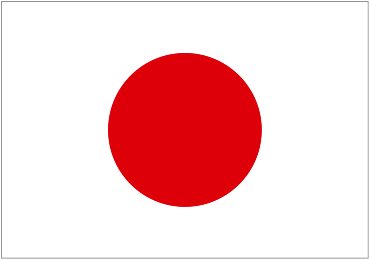




Fall 2010? - Headquarters and Public Education Center (PEC), US Institute of Peace (USIP), 23rd Street & Constitution Avenue, NW, Washington, DC (USA). Official ground breaking took place June 5, 2008, twenty-four years after the creation of USIP. The facility will consist of a training center for professional conflict managers, conference space for public and private meetings, office space for USIP staff, and a 20,000 square foot PEC. Entry #1169 in the "Peace Movement Directory" by James Richard Bennett (2001). Click here for the Wikipedia article.


















